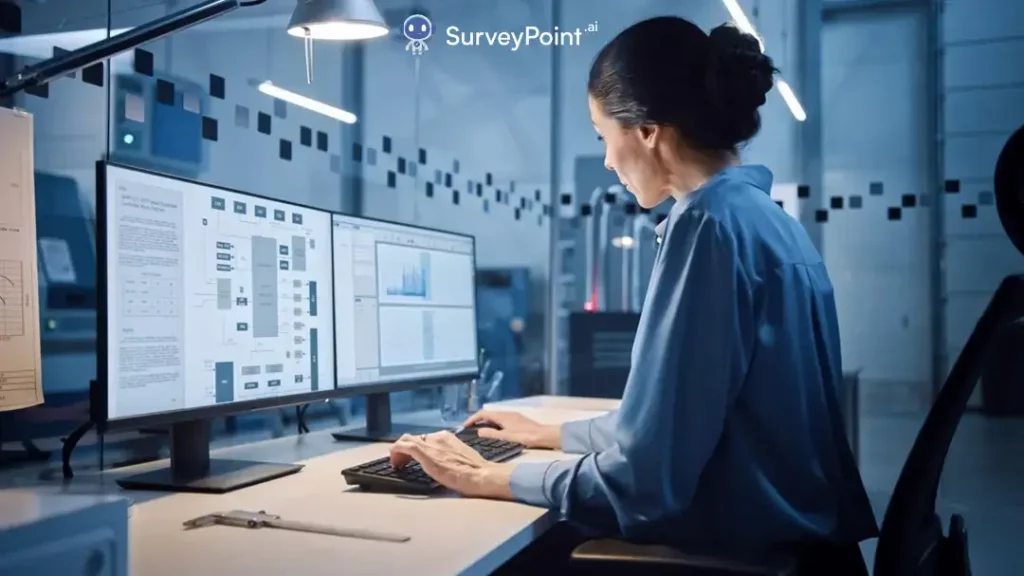Data visualization is a strong tool that helps people and businesses understand and share complicated data in a way that looks good. In the data-driven world of today, where information is plentiful and easy to find, the ability to visualize data successfully is becoming more and more valuable. If you work in business and want to make decisions based on data or if you are a data scientist trying to explain your results to others, you need to know the basics of data visualization.
How to Get Started with Data Visualization
To really use the power of data visualization, you need to know what it is and why it is so important. Data visualization is the process of showing data in a visible way, using charts, graphs, and maps, for example. When data is shown in a visible way, it is easier to see patterns, trends, and connections. This helps to break down complicated information, making it easier for others to understand.
What is Data Visualization?

The process of turning raw data into graphical representations is called “data visualization.” It includes using things like colors, shapes, and sizes to encode data and send information that makes sense. By showing data in a visible way, it’s easier to spot patterns, outliers, and trends, which leads to better understanding and insights.
Visualizing data is not a new idea. In fact, people have been using pictures to share information with each other for thousands of years. From cave paintings to old maps, putting data into pictures has always been a good way to make difficult information easier to understand.
Data representation has changed a lot since technology came along. We now have access to strong tools and software that let us make visualizations that are interactive and change over time. With these tools, we can look at data in real time, change factors, and find insights that may not be obvious from the raw data alone.
How important data visualization is in the world today
We get a lot of information every day in the information age we live in now. From sales numbers to trends on social media, data is all around us. But it’s not enough to just have access to info. What sets successful people and groups apart is their ability to understand and share this information. This is where visualizing data comes in.
Visualizing data lets us turn complicated information into pictures that are easier to understand and make sense of. It helps us find patterns, outliers, and trends that might not be obvious from the raw data alone. By showing data in a visual way, we can explain complicated information more clearly, which leads to better decisions and better results.
Also, data visualization lets us use numbers to tell interesting stories. By combining visual aspects with storytelling, we can make presentations that are interesting, powerful, and stick with the audience. This is especially important in areas like journalism, where data visualization can be used to get important information across and bring attention to important problems.
Key Parts of Visualizing Data
There are a number of important parts that go into making good data visualizations. These things are:
Clarity: The visual should make it clear what the message is and leave no room for misunderstanding. It should be easy to understand and figure out, even for people who don’t know much about analyzing data.
Simplicity: The representation should be clear and to the point, with no extra details. Extraneous parts can take attention away from the main point and make it harder to understand the picture.
Relevance: The visualization should put the most important facts front and center and leave out anything else. Putting in too much information can make the watcher feel overwhelmed and water down the main point.
Consistency: The whole image should have the same style and layout. This makes it easy for the person looking at the data to understand and make sense of what it all means.
Accuracy: The representation should show the data exactly as it is, without distorting or misrepresenting it. It’s important not to misrepresent or change facts in ways that could lead to wrong conclusions or choices.
Aesthetics: The visualization needs to look good and use the right colors, fonts, and patterns. Aesthetics are very important for getting people’s attention and getting them interested in the facts.
By keeping these key points in mind, data visualizations can successfully convey complex information, make it easier to understand, and lead to meaningful insights. Data visualization is a powerful tool that can help us learn more about the world around us. It can be used to look at sales data, track social media trends, or explore scientific research.
Different ways to show data
There are a lot of different kinds of data visualizations that can be used to show data. Each type of visualization has its own pros and cons, and the one you choose will depend on the data you want to show and the lessons you want to share.
Charts and graphs are two of the most popular and well-known ways to show data. These pictures are a good way to show numbers and can be used to show trends, similarities, and percentages. There are many different kinds of graphs and charts, such as bar charts, line graphs, pie charts, and scatter plots. Bar charts are great for comparing different groups or categories, while line graphs are good for showing how things have changed over time. Scatter plots are great for showing how two factors are related, while pie charts are great for showing proportions or percentages.
Infographics are another popular way to show facts in a visual way. Infographics use text, pictures, and other visuals to make complicated information more interesting and easy to understand. They are often used to make hard ideas easier to understand and simpler. Infographics can successfully show information and data in a visually appealing way by using a mix of colors, icons, and illustrations.
Heat maps are another popular way to show data in a clear way. Heat maps use colors to show how much information there is. They are especially helpful in business and geography, where trends and clusters of data need to be shown. When you have a lot of data, heat maps are especially useful because they can help you find outliers or interesting places. Heat maps are a quick and easy way to see how data is spread out. They do this by using a color shift.
Geographic maps are another common way to show facts. These charts are made to show information based on where it is in the world. They can be used to show different kinds of location-specific information, like the number of people living in a certain area, how sales are spread out, or any other data that is related to a certain area. Geographic maps are especially good for understanding spatial links and patterns because they show how data is spread across different areas.
In conclusion, there are many different kinds of data displays, and each has its own benefits and uses. Whether you use charts and graphs, infographics, heat maps, or geographic maps, the most important thing is to choose the type of display that fits your data the best and helps you get your point across.
You Must Read Data Visualization: Meaning, Tools and Techniques Top 10 Techniques for statistical tests that give accurate results Understanding Method vs. Methodology: A Comprehensive Guide
How to Make Good Visualizations of Data
Planning and thinking carefully are needed to make effective data visualizations. Follow these steps to make sure your images are powerful and meaningful:
Getting to Know Your Data
Start by being clear about the facts you want to show. Find the variables and connections you want to study and learn more about. This will help you decide how to display your data and make sure you pay attention to the most important parts.
For example, if you are working with sales data, you might want to find the key metrics, such as income, units sold, and profit margin. If you understand how these factors relate to each other, you will be able to make visuals that show how well your sales team is doing.
Also, think about where your info came from. Is it coming from a computer, a spreadsheet, or an API? Knowing where the data came from can help you figure out if there are any limits or biases that might affect how you visualize it.
How to Choose the Right Type of Visualization
Once you know what data you want to show, choose the type of visualization that best shows what you want to say. Think about the kind of data you have, the patterns you want to show, and the people you want to reach. Choose carefully, because different types of visualization are best for different jobs.
For example, a line chart may be the best choice if you want to compare how well different goods have done over time. On the other hand, a histogram or a bar chart might be better if you want to show how a single variable is spread out.
It is also important to think about how your images will be shown. Are you making a report for leaders, a presentation for coworkers, or an interactive dashboard for clients? Customizing your visuals to fit the wants and tastes of your audience will help them understand and be more interested.
Creating your mental picture
Pay close attention to the details when making your picture. Think about where and how you put your visual features, how you use color and contrast, and how the whole thing looks. Make sure your picture is simple and easy to understand, and don’t add any extra details.
Choosing the right colors is one of the most important parts of design. Colors can make us feel things and say things, so choose a color palate that fits with what you want to say. For example, using warm colors like red and orange can show urgency or excitement, while using cool colors like blue and green can make people feel calm or trusting.
Labels and notes are also something to think about when designing. By giving your visual elements clear labels, you can give context and help your audience understand the information properly. Annotations, like lines or callouts, can point out certain data points or give more information about them.
How to Figure Out What You Saw
Lastly, once your visualization is done, you need to interpret and study the information it gives you. Look for patterns, trends, and things that don’t fit with what you know. Think about what this means and what conclusions can be made. Don’t forget that the point of data visualization is not just to make pretty pictures, but to learn something useful.
For example, if you see a sudden rise in sales at a certain time, you might look into what marketing campaigns or outside causes led to that rise. On the other hand, if your customer satisfaction scores are going down, you might look into why and take steps to fix the problem.
Also, data representation can help you find problems with data quality or oddities. By seeing how your data looks, you may be able to spot differences or outliers that need more study. This can lead to processes for cleaning or improving your data, which makes sure that your insights are correct and reliable.
Tools for making sense of data
There are many tools, from simple chart makers to powerful data analytics systems, that can be used to visualize data. Some famous tools for showing data are:
An Overview of Tools for Visualizing Data
PowerBI is a business intelligence tool from Microsoft that lets users make interactive charts and reports.
Tableau is a popular business intelligence and data visualization app that has a wide range of tools and features.
D3.js is a JavaScript library that lets you make your own data visualizations using powerful and flexible tools.
How to Choose the Right Tool for You
When choosing a data visualization tool, you should think about your level of skill, your budget, and your unique needs. Some tools may be better for people who are just starting out, while others have more advanced features for people who have used them before. Also, think about how well it works with the data sources you already have and how much help and training you can get.
By using the power of data visualization, people and groups can find useful insights and better explain complicated information. To become an expert in this field, you need to know the basics of data visualization, try out different types of visualization, follow an organized process, and choose the right tools. In today’s data-driven world, anyone can use the power of data visualization to make better decisions. All they need are the right skills and tools.




